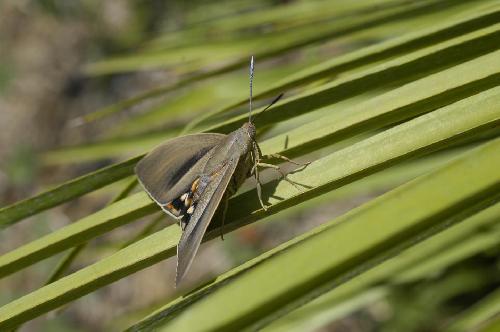A new study led by ICTA-UAB (Universitat Autònoma de Barcelona) researcher Víctor Sarto and colleagues from the Institute of Advanced Chemistry of Catalonia (CSIC-IQAC) has described for the first time in two centuries of knowledge a case of evolutionary convergence in the order of butterflies (Lepidoptera), certainly representing an evolutionary breakthrough to what has been known about their sexual communication. The research has discovered important behavior and physiological changes in the mating process of the moth Paysandisia archon (Castniidae). This neotropical moth that reached Europe in 2001 from Argentina (also inhabiting Uruguay and Brasil) breaks the known sexual rules by behaving like a diurnal butterfly.
The moth's behavior was already described as "strange" by scientists when this new species reached Europe by sea, hiding within infested palms in big ship cargoes. For the next 15 years it spread eastward along the Mediterranean basin to other countries and reached Bulgaria, Greece and Cypress, causing considerable havoc among palm trees.
Researchers noticed there was something very special concerning this moth. Strangely, the adults (males and females) behaved quite differently to other moths, so much that they acted more like butterflies than moths. This therefore prompted further research into the 'alien' moth.
 Paysandisia archon (Castniidae). Credit: Víctor Sarto
Paysandisia archon (Castniidae). Credit: Víctor Sarto
Lepidoptera (butterflies and moths) is one of the most diverse insect groups with currently about 160,000 described species. Within this vast group of insects and until 2012, only two basic partner-finding strategies pertaining to 'butterflies' and 'moths' were known. In short, in the case of butterflies (which are primarily diurnal) males use their vision to detect conspecific females at some distance and pursue them. Female butterflies, in turn, have no sex pheromone glands in their ovipositors and therefore do not release any long-range pheromone to attract males.
In contrast, in the case of moths (mostly nocturnal), males use their olfactory system to detect females at some distance because the latter release long-range pheromones from their pheromone glands. Once together and in close courtship interactions, males (butterflies and moths), and in some cases also females, release close range pheromones or 'scents' that facilitate or hinder the last courtship steps leading to copulation.
The butterflies simply use vision to find mates in their sunlit environment with no need to produce long-range sex pheromones. The moths, in turn, maintain the so-called "female calling plus male seduction" strategy, which implies the production of long-range sex pheromones.
In two recent papers published in 2012 and 2016, ICTA-UAB researcher Víctor Sarto demonstrates that this alien moth, Paysandisia archon, breaks the known rules by behaving like a butterfly.
Among their abnormal behaviour, it is highlighted that males are territorial, use only vision for partner-finding, females do not release pheromones to attract males and have even lost their pheromone glands (which are normally located in the ovipositor) to the extent that they resemble female butterflies. "All these attributes are new and have no parallel in the world of moths, certainly representing an evolutionary breakthrough to what has been known about sexual communication in Lepidoptera" says Víctor Sarto who states that this evolutionary convergence has taken place since day-flying moths have been subject to analogous evolutionary pressures such as those of butterflies.
source: Universitat Autonoma de Barcelona